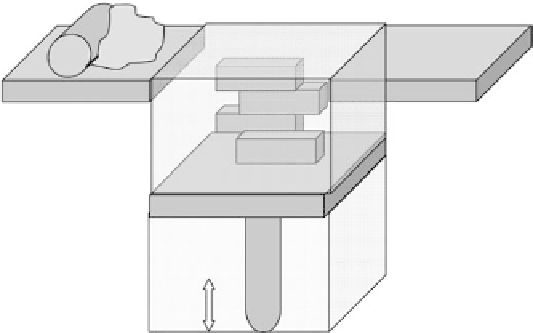Biomedical Engineering Reference
In-Depth Information
4.6.2 T
HREE
-D
IMENSIONAL
P
RINTING
Originally developed for rapid-prototyping ceramics and metal objects such as molds for investment
casting, three-dimensional printing (3-DP) has since been applied to the fabrication of drug delivery
devices and tissue scaffolds from biomedical polymers. It allows simultaneous fabrication and surface
modifi cation of 3-D devices. A schematic description of the 3-DP process is shown in Figure 4.7.
A thin layer of powder (0.05-0.20 mm) is fi rst spread on the top of a piston. An ink-jet printhead
then prints a liquid binder onto the layer wherever the particles are to be bonded together to form
the solid part of the object. Colloidal silica is commonly used as a binder in ceramic systems, while
organic solvents such as chloroform, which swell and partially dissolve individual powder particles,
are suitable for polymer systems [16].
Each printed droplet is 50-80 µm in diameter, and a CAD/CAM program controls its position.
After the fi rst layer is printed, the piston is dropped, and the sequential steps of powder spreading
and printing are repeated. Scaffolds possessing complex internal features can be created because
during the building process, the powder bed allows the formation of channels and overhangs as
supports for objects. Furthermore, multiple printheads containing different solutions can be read-
ily employed to modify local surface chemistries and compositions. At the end of the process, the
scaffold is lifted from the powder bed, and the loose powder is removed. The resulting product is
a solid, continuous 3-D structure with well-defi ned internal microarchitectures. The resolution of
features is approximately 300 µm. Interconnected pores can be generated in the walls of polymer
Ink-jet
Roller
Powder
3-D scaffold
Piston
FIGURE 4.7
Basic scheme of the 3-D printing method.


















